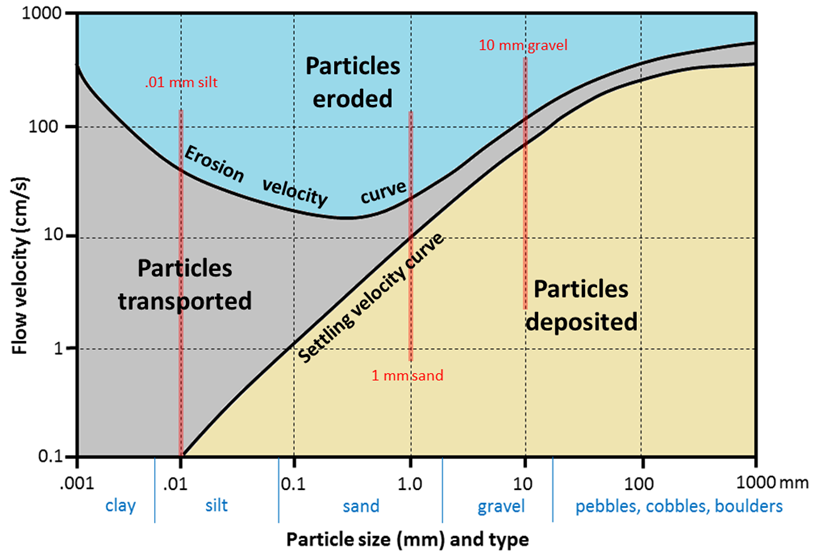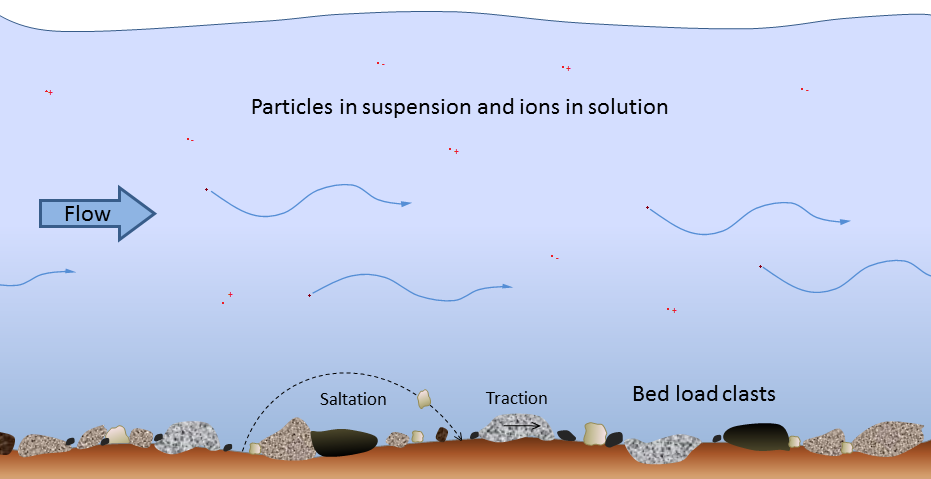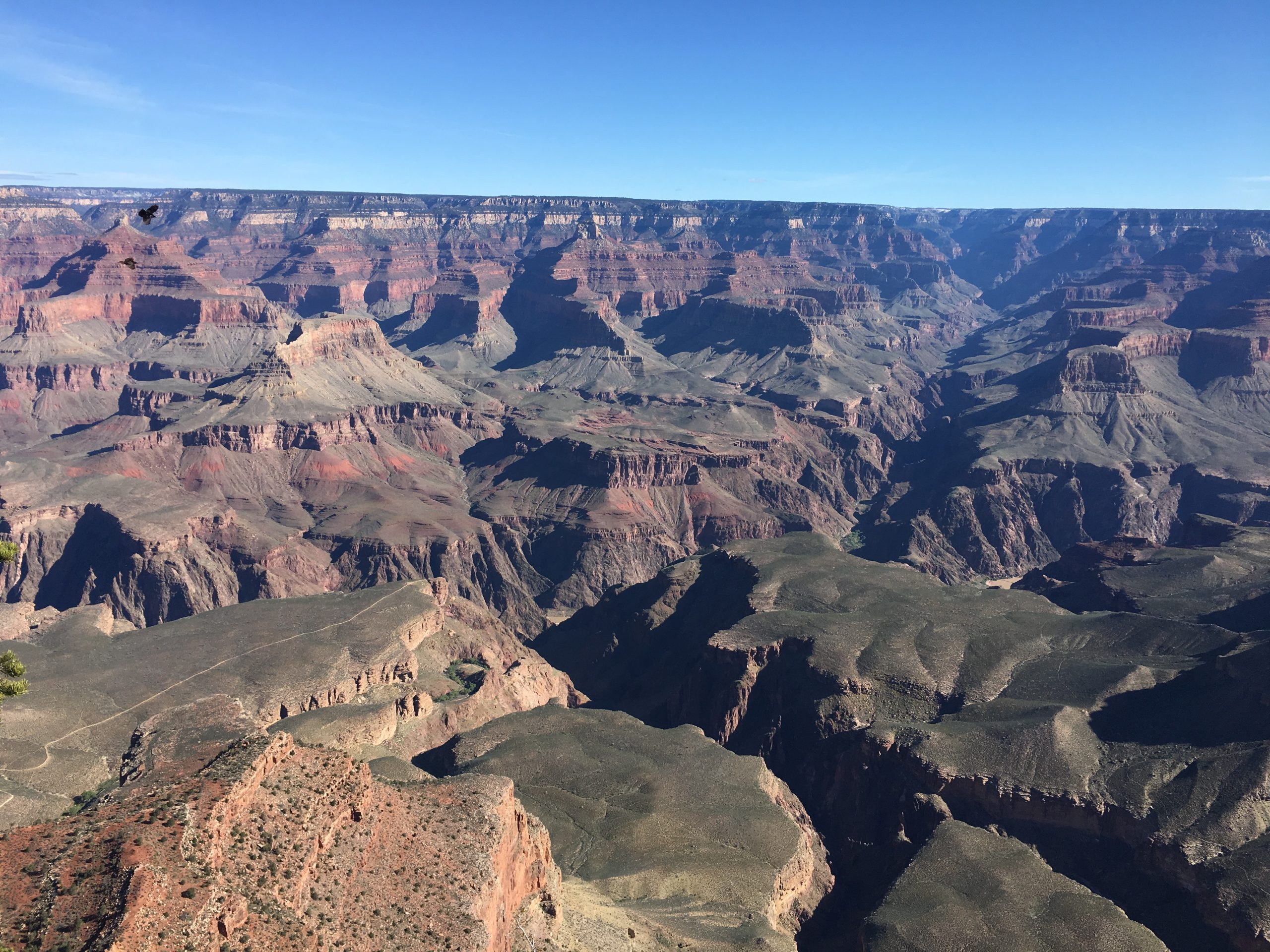12.3 Stream Erosion and Transportation
Flowing water is a primary mechanism for erosion, transportation, and deposition. There are many factors that can control how quickly or how much water will flow within a stream, but it is primarily related to the stream’s gradient, or slope, as well as the shape of the stream. All of the water that reaches a stream contains sediment that has been carried from the entire drainage basin.
Stream Erosion
Erosion is the geological process in which materials are worn away and transported by natural forces such as wind or water, and streams are very efficient agents of erosion. The faster the water is flowing, the larger the particles that can be kept in suspension and transported within the flowing water. However, as Swedish geographer Filip Hjulström dis-covered in the 1940s, the relationship between grain size and the likelihood of a grain being eroded, transported, or deposited is not as simple as one might imagine (Fig. 6.3.1). Consider, for example, a 1 mm grain of sand. If it is resting on the bottom, it will remain there until the velocity is high enough to erode it. However, once it is in suspension, that same 1 mm particle will remain in suspension as long as the velocity does not drop below 10 centimeters per second (cm/s.) For a 10 mm gravel grain, the velocity is 105 cm/s to be eroded from the bed but only 80 cm/s to remain in suspension (3).

On the other hand, a 0.01 mm silt particle only needs a velocity of 0.1 cm/s to remain in suspension but requires 60 cm/s to be eroded. A tiny silt grain requires a higher velocity to be eroded than a grain of sand that is 100 times larger. For clay-sized particles, the discrepancy is even more significant. In a stream, the most easily eroded particles are small sand grains between 0.2 mm and 0.5 mm. Anything smaller or larger requires a higher water velocity to be eroded and entrained in the flow. The main reason for this is that those small particles, especially the tiny grains of clay, have a strong tendency to stick together, so they are challenging to erode from the stream bed (3).
Stream Transportation
Streams transport large quantities of materials from the headwaters all the way to the mouth of the stream where it intersects a lake or ocean. There are three types of sediment that are carried:
- Large particles rest on the bottom, typically anything larger than sand, is called bedload, and may only be moved during rapid flows under flood conditions. They can be moved by saltation (bouncing) and by traction (being pushed along by the force of the flow).
- Smaller particles may rest on the bottom some of the time, where they can be moved by saltation and traction, but they can also be held in suspension in the flowing water, especially at higher velocities. They are referred to as suspended load.
- Stream water also has a dissolved load, representing roughly 15 percent of the mass of material transported, and includes ions such as calcium dissolved load and chloride in solution. The solubility of these ions is not affected by flow velocity (Earle, 2019).

Stream Deposition
Because streams carry a tremendous amount of sediment, they also deposit that sediment. Flooding events typically deposit dissolved and suspended sediments onto floodplains, but larger particles can also be deposited depending on water discharge.
 Backyard Geology: Colorado River Sediment Carry
Backyard Geology: Colorado River Sediment Carry
One of the more spectacular examples of Colorado River erosion is the formation of the Grand Canyon. Millions of visitors a year visit this beautiful landscape that highlights stream movement through a dynamic landscape.

- Stream Erosion: Between 5-6 million years ago, the Colorado River and its tributaries began carving through the underlying rocks.
- Stream Transportation: Sediment transport in the Colorado River at the Grand Canyon has been extensively studied. Because the water flow is now tightly controlled through a series of dams, sediment transport has dramatically been affected. It is estimated that the River would have carried over 500,000 tons of sediment through the Grand Canyon daily before the construction of the Glen Canyon Dam.
- Stream Deposition: Lake Mead, the largest lake on the Colorado River, is formed by the Hoover Dam, built in 1935. Due to the sediments that fill the lake over time, it was estimated that Hoover Dam would only last 200 years before it was overtopped with sediment. With the construction of Glen Canyon Dam upstream, Hoover is now expected to last a thousand years. However, Glen Canyon Dam sedimentation is now the focus of analysis (National Park Service).
land area drained by a stream and its tributaries
the geological process in which materials are worn away and transported by natural forces such as wind or water
Large particles resting on the bottom of a stream.
bouncing of sediment on the bed of a stream
small sediment carried by a stream
material in solution that is carried by a stream
a flat-lying area of land next to a stream that experiences flooding during periods of high discharge

